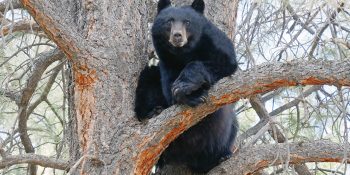DENVER – One-third of all bear reports in Colorado last year have been traced back to having trash involved as an attractant.
Colorado Parks and Wildlife received 4,943 bear reports in 2020 and 1,661 (33.6 percent) had trash documented. Trash is not the only problem leading to human-bear conflicts. Bird feeders (411 reports), unsecured chicken coops (254) and livestock (391), among others, are all pieces of the puzzle wildlife officials document when tracing conflicts.
Overall, the 4,943 reports filed on bears was down slightly from the 5,369 in 2019. Reports were up in the southeast (up 23.6 percent) and northeast (up 6.3 percent) regions of the state, but down in the northwest (23.5 percent) and southwest (18.6 percent).
“Unfortunately I would classify 2020 as a fairly ‘normal’ year for bear activity,” said Area 8 Wildlife Manager Matt Yamashita. “‘Unfortunate’ is in reference to the still substantial number of conflict bear calls across the state. Compared to 2019 statistics it appears that human-bear conflict numbers have decreased and the situation is improving. However, wildlife managers are hesitant to draw conclusions from a comparison between two years.
“As with many aspects of wildlife management, managers look to identify trends in data over several years to ensure that change is persistent and meaningful.”
Read the full Q&A on bear conflicts with Area Wildlife Manager Matt Yamashita.
CPW euthanized 120 bears in 2020 and relocated 89. The number of bears put down and relocated in the previous five years: 2019: 92 euthanized, 44 relocated; 2018: 63 euthanized, 24 relocated; 2017: 216 euthanized, 109 relocated; 2016: 36 euthanized, 16 relocated; 2015: 65 euthanized, 40 relocated.
Trash and bird feeders are typically a bear’s first association with people. It is their first step that leads them to becoming habituated, or losing their natural fear of humans. After learning this house or neighborhood has easy calories available to them in those forms, the next place they may look to for more is in an open garage, or pet food on your deck, or even break into your car for a treat it can smell.
Being rewarded with food over time makes a bear willing to take greater risks to get the calories it needs. The next and most dangerous step they may take is to break into a home. In 2020, CPW documented 362 reports that had bears breaking into homes, cabins, dwellings and garages (forcible entry into a garage, not walking into one left open).
Breaking into a home is the leading cause of bears being put down. If residents want to take action to keep Colorado’s bears safe, securing their trash and not having a birdfeeder out from March until after Thanksgiving is the most important step that should be made. They should also ask their neighbors to do the same, because it takes a community-wide effort to remove attractants and reduce bear conflicts.
CPW listed 687 reports associated with other attractants. Those can be pet food, BBQ grills, coolers or attractants in tents while people are out camping, fruit trees in your backyard, compost and others.
Bear conflicts with livestock were documented 391 times in 2020 with most of those associated with sheep, goats or unsecured livestock feed. In addition to those numbers, there were 254 reports of bears getting into chicken coops and 74 beehives.
For information on what you can do to reduce human-bear conflicts, please visit our website. Communities are encouraged to work with their local wildlife officers to identify the source(s) of conflicts where they live and proactively work together to mitigate the problems which lead to negative interactions with our bruins.
SPREAD THE NEWS
COMMENT, Like, Follow & SHARE @I70Scout
CURRENT EDITION
WEATHER & TRAFFIC PUZZLES RECENT NEWS ADVERTISE WITH US










